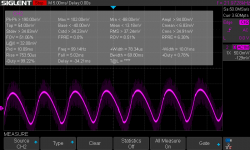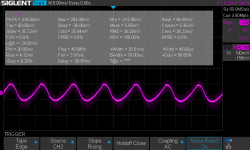Well I am pretty stupid though 🙂
I did a year of electronics and cct theory at Uni, but very little of it stuck. I was more interested in the digital and protocol side - which I ended up doing as a career, designing comms protocols and such like.
Anyway, base resistors from what I remember are there to limit the base to emitter current and usually bias the transistor, but in a class A amp, I'm a bit unsure what they do, other than limit current...and then I don't quite see in some amps why they are omitted, and hence have no current limit, though other amps have them. I assume again that they are limiting the current for thermal stability, but with a chunk of current flowing C to E I would have though the Ib would have been a small thermal contributor.
I'll go back to tactical comms now...lol

I did a year of electronics and cct theory at Uni, but very little of it stuck. I was more interested in the digital and protocol side - which I ended up doing as a career, designing comms protocols and such like.
Anyway, base resistors from what I remember are there to limit the base to emitter current and usually bias the transistor, but in a class A amp, I'm a bit unsure what they do, other than limit current...and then I don't quite see in some amps why they are omitted, and hence have no current limit, though other amps have them. I assume again that they are limiting the current for thermal stability, but with a chunk of current flowing C to E I would have though the Ib would have been a small thermal contributor.
I'll go back to tactical comms now...lol

Well I'm still really enjoying this amp through a miniDSP. I find its soundstage very wide with some great separation between instruments. Warmer than the F5T.
It still however has a buzz in the speakers, not volume related. I've tried shorting the inputs, but the buzz remains. Next try is to isolate one channel on its own PSU/transformer, though I'm not convinced it is a grounding issue. I'm also going to take out the soft power on cct, just in case.
Has anyone else built one of these amps great sounding amps?
I am considering changing the OS to 8 way to best use the 400mm heatsink.
It still however has a buzz in the speakers, not volume related. I've tried shorting the inputs, but the buzz remains. Next try is to isolate one channel on its own PSU/transformer, though I'm not convinced it is a grounding issue. I'm also going to take out the soft power on cct, just in case.
Has anyone else built one of these amps great sounding amps?
I am considering changing the OS to 8 way to best use the 400mm heatsink.
Mains hum...
I've had a little bit of time to investigate where this hum is coming from and I noticed something quite strange; it seems to be heat related. I turn the amp on and there is no hum through the speakers, but after about a hour or so it becomes quite noticeable from say 3 meters away.
Zipped hum: View attachment 20211025-2237_Recording_5.zip
Recorded close to the treble panel of a Quad 57.
Looking at the PSU the left and the right rails look like this:


Guess the hum is coming from the PSU.
Solution is to go back to a standard rectifier and a few big cans rather than the active rectifier the amp gas atm. Sometimes the old ways are the best. 🙂
I've had a little bit of time to investigate where this hum is coming from and I noticed something quite strange; it seems to be heat related. I turn the amp on and there is no hum through the speakers, but after about a hour or so it becomes quite noticeable from say 3 meters away.
Zipped hum: View attachment 20211025-2237_Recording_5.zip
Recorded close to the treble panel of a Quad 57.
Looking at the PSU the left and the right rails look like this:


Guess the hum is coming from the PSU.
Solution is to go back to a standard rectifier and a few big cans rather than the active rectifier the amp gas atm. Sometimes the old ways are the best. 🙂
I've had a little bit of time to investigate where this hum is coming from and I noticed something quite strange; it seems to be heat related. I turn the amp on and there is no hum through the speakers, but after about a hour or so it becomes quite noticeable from say 3 meters away.
Zipped hum: View attachment 994305
Recorded close to the treble panel of a Quad 57.
Looking at the PSU the left and the right rails look like this:
View attachment 994303
View attachment 994304
Guess the hum is coming from the PSU.
Solution is to go back to a standard rectifier and a few big cans rather than the active rectifier the amp gas atm. Sometimes the old ways are the best. 🙂
Can you post a picture of your PSU?
A correctly implemented LT4320 active rectifier and filter does not add noise to an amplifier. I wonder if something else is going on?
I think it is just PSU ripple noise getting out on to the speakers...but strangely I can hear it on the speakers, but not measure it 🙁Can you post a picture of your PSU?
A correctly implemented LT4320 active rectifier and filter does not add noise to an amplifier. I wonder if something else is going on?
The plots above are taken from the output of the PSU.
I went back to July and saw your using Prasi's LT4320 CRC boards. Very nicely made. I am not familiar with the Stasis amp don't know what the bias current is. If its ripple getting through maybe try CRCRC or a capacitance multiplier?
Maybe ground loop? Try connecting an NTC is series from a psu gnd tab to your star ground point on your chassis. (both psu boards)
Maybe ground loop? Try connecting an NTC is series from a psu gnd tab to your star ground point on your chassis. (both psu boards)
Last edited:
good
you have space to add more caps

what amount of capacitance you have?
and what is Iq in present moment?
Bias is set at about 1.2A per rail (200mVs over each OS emitter resistor), so each channel is about 2.4A.I went back to July and saw your using Prasi's LT4320 CRC boards. Very nicely made. I am not familiar with the Stasis amp don't know what the bias current is. If its ripple getting through maybe try CRCRC or a capacitance multiplier?
Maybe ground loop? Try connecting an NTC is series from a psu gnd tab to your star ground point on your chassis. (both psu boards)
Interestingly I have tried CapMXs and had the same buzz 🙁
I have star earth from the PSU's GND to earth via a NTC. I've tried disconnecting the earth from the GND, but that had no effect on the buzz.
ZM did recommend a fat wire between either the FE gnds or the OS gnds - I've tried neither of those so far...my bad.
Strangely, I thought of your post too when I was thinking about what to do...what amount of capacitance you have?
and what is Iq in present moment?
4*22,000uF per channel. 2.4A per channel.
Last edited:
you need more uF
simple as that
just for giggles - to test my hypothesis - decrease Iq to 1A5 and hear is it there decrease in hum, when amp is temp. equilibrium
if decreased Iq lead to decrease of hum, that's it
btw, you can resort to CLC , without increase of uF
though, I wouldn't go for less than 3mH, having 22mF as basic cell
lazy to type, resonant freq. can be calc if you look at LC circuit - Wikipedia
going above 20Hz for that is no-no
lower even better
simple as that
just for giggles - to test my hypothesis - decrease Iq to 1A5 and hear is it there decrease in hum, when amp is temp. equilibrium
if decreased Iq lead to decrease of hum, that's it
btw, you can resort to CLC , without increase of uF
though, I wouldn't go for less than 3mH, having 22mF as basic cell
lazy to type, resonant freq. can be calc if you look at LC circuit - Wikipedia
going above 20Hz for that is no-no
lower even better
Last edited:
I did wonder whether it was lack of capacitance.you need more uF
simple as that
just for giggles - to test my hypothesis - decrease Iq to 1A5 and hear is it there decrease in hum, when amp is temp. equilibrium
if decreased Iq lead to decrease of hum, that's it
btw, you can resort to CLC , without increase of uF
though, I wouldn't go for less than 3mH, having 22mF as basic cell
lazy to type, resonant freq. can be calc if you look at LC circuit - Wikipedia
going above 20Hz for that is no-no
lower even better
I shall try your advice and reduce the Iq to see if the ripple dries up. I shall report my findings...
Thank you for the pointers ZM.
How many uF does a Stasis 3 have per channel?
dunno
neither I know what's Iq in original
you started practically with nothing uF, as I remember ...... now you need to pay the price
neither I know what's Iq in original
you started practically with nothing uF, as I remember ...... now you need to pay the price

dunno
neither I know what's Iq in original
you started practically with nothing uF, as I remember ...... now you need to pay the price
Indeed ZM 🙂
It's a learning thing...though I would have thought 88,000uF per channel sufficient; well I thought wrong 🙁
A good excuse to start digging through my capacitor box and suppliers' web sites....happy times.
you have hefty Iq, too
and Stasis OS isn't exactly best one, when talking about ripple rejection
emiters and bases are referenced to rails ......
anyway, before digging through wallet, try decreasing Iq and observe results
feel free to halve it .... worse thing can happen is that you hear slight KlunK! from time to time
🙂
and Stasis OS isn't exactly best one, when talking about ripple rejection
emiters and bases are referenced to rails ......
anyway, before digging through wallet, try decreasing Iq and observe results
feel free to halve it .... worse thing can happen is that you hear slight KlunK! from time to time
🙂
- Home
- Amplifiers
- Pass Labs
- New Stasis front end